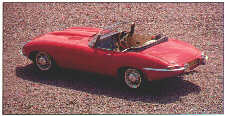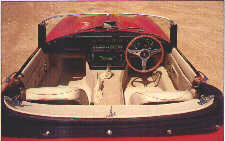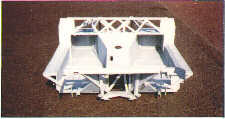CHALLENGER COMMENT
Views and
opinions from the experts
Ian
Hyne from KIT CAR is impressed

"They
said there would never be another car like the E type Jaguar" proclaim
the adverts from Triple C, going on to say "but now it has a serious
rival; the Challenger". Such advertising comparisons are nothing
new from the replica manufacturers but, in the case of the Challenger,
I can reveal that Derek Robinson and John Wilkinson are fully justified
in their claims. The long, low, red car glittered in the glorious sunshine
of a brilliant summer's day. Opening the door and sliding into the
driver's
seat, I raised my eyes to behold a sight that could only belong to
one car. The undulating bonnet

Challenger
is the star of the show and its performance is not very far away from
the original dream machine either, thanks to a Jaguar 4.2-litre power
plant under the bonnet. That gives the car the 150 mph performance of
the original as well as electrifying acceleration at 0 to 60mph in a staggering
5.1 seconds. Even more power is available for the lion-hearted few if
Triple C is allowed to tweak and twiddle with the Jaguar production engine.
The 1988 version has a few benefits that would make original E type owners
grateful even now. For a start the Challenger is rust free because of
its fibreglass and zinc-coated chassis. That gives the model a life expectancy
as good as anything on the market, plus some pretty good handling characteristics.
projecting
from the dashboard decorated with the huge Jaguar clocks could only belong
to an E type. If there was ever any doubt, twisting the key prompted the
classic twin cam to confirm it. The car billed as being dimensionally
and visually identical to the series 1 E type and while that is perfectly
true, you are immediately aware of a most unusual E type trait; the low
speed ride is extremely comfortable. Slotting into the Corby town traffic,
the warmed up engine pushed the car along with seemingly indifferent ease
reaching top with around 1500 revs in evidence and holding it without
effort. Indeed, reaching the quicker stretches of dual carriageway, the
Challenger overcomes the need to change gear by pulling strongly and instantly
the throttle goes down. However, drop a cog and hit the pedal and the
car digs it heels in and goes off like rocket. The rev counter is red
lined at 6000 but how on earth public roads ever give you the chance to
get the needle anywhere near it, heaven only knows. 3000 is more than
adequate for fast road driving and even then, your speed is stretching
the discretion of the boys in blue! Normally 2500 will maintain the legal
limit while taking it to 3000 in the gears and popping in the overdrive
will bring it back to the 2500 mark. Truly the car has the power to match
the 150 mph top speed quoted for the original cars and, while you may
never have the chance to do it, you can certainly enjoy the acceleration
the car has to offer. So, if you have ever imagined yourself cruising
down the highway behind the wheels of an E type, the Challenger represents
the chance of a lifetime. They said there would never be another but,
they were wrong.

As
can be seen, a great deal of effort has gone into the Challenger's chassis,
with the concomitant rewards. At a kerbside weight of 984 kg the Mark
Two version is some 136 kg lighter than its predecessor, not to mention
a massive 341 kg lighter than the original. In addition, the new chassis'
torsional stiffness is 20% higher and accident protection, particularly
side impact protection, is much improved. By the way, should the use of
sheet steel, with its habit of corroding, be concerning you there is no
problem. Production chassis are supplied flame sprayed in molten zinc
to BS 2569, as seen on good oil rigs everywhere. The lifespan of this
coating is in the order of 25 years.